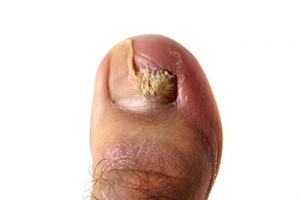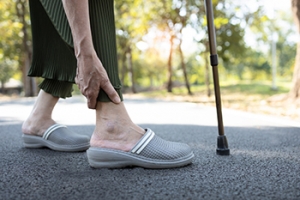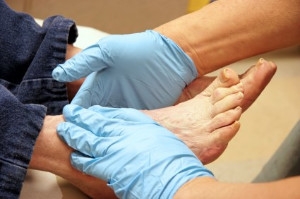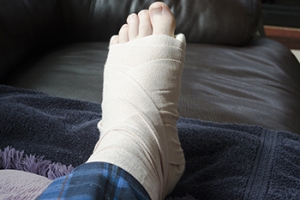Connect With Us
Featured Articles
Super User
Broken Toe and Nerve Injury

When an individual breaks their toe, the fracture might cause any number of different side effects in relation to the toe. For example, one important side effect of breaking your toe includes, in some cases, the possibility of nerve damage. There are several significant nerves in the toes. In fact, there is a nerve on each side of each toe. Not only does this mean that the toes can be particularly sensitive, it also means that a broken toe can cause nerve damage. It is important to note that if you develop sensations of numbness in the toe after a fracture occurs, then you should seek out medical attention immediately, as this is a sign of nerve damage. Those who suffer from diabetes are at an increased risk of experiencing some kind of nerve damage or abnormality. If you have recently endured a toe fracture and are concerned about the ramifications that it might have on the nerves in your feet, consult a podiatrist today.
A broken toe can be very painful and lead to complications if not properly fixed. If you have any concerns about your feet, contact Scott Matthews, DPM, MD from Salem Foot Care . Our doctor will treat your foot and ankle needs.
What to Know About a Broken Toe
Although most people try to avoid foot trauma such as banging, stubbing, or dropping heavy objects on their feet, the unfortunate fact is that it is a common occurrence. Given the fact that toes are positioned in front of the feet, they typically sustain the brunt of such trauma. When trauma occurs to a toe, the result can be a painful break (fracture).
Symptoms of a Broken Toe
- Throbbing pain
- Swelling
- Bruising on the skin and toenail
- The inability to move the toe
- Toe appears crooked or disfigured
- Tingling or numbness in the toe
Generally, it is best to stay off of the injured toe with the affected foot elevated.
Severe toe fractures may be treated with a splint, cast, and in some cases, minor surgery. Due to its position and the pressure it endures with daily activity, future complications can occur if the big toe is not properly treated.
If you have any questions please feel free to contact our office located in Wikesboro, NC . We offer the newest diagnostic and treatment technologies for all your foot and ankle needs.
What to Know About a Broken Toe
Trauma to the foot, especially the toes, can occur in many ways. Banging them, stubbing them, or dropping something on them are a few different ways this trauma can occur. Given the fact that toes are positioned in front of the feet, they typically sustain the brunt of such trauma. When trauma occurs to a toe, the result can be a painful break or fracture. Another type of trauma that can break a toe is repeated activity that places stress on the toe for prolonged periods of time.
Broken toes can be categorized as either minor or severe fractures. Symptoms of minor toe fractures include throbbing pain, swelling, bruising on the skin and toenail, and the inability to move the toe with ease. Severe toe fractures require medical attention and are indicated when the broken toe appears crooked or disfigured, when there is tingling or numbness in the toe, or when there is an open, bleeding wound present on the toe.
Generally, a minor toe break will heal without long-term complications. However, it is important to discontinue activities that put pressure on the toe. It is best to stay off of the injured toe and immediately get a splint or cast to prevent any more additional movement of the toe bones. You can also immobilize your toe by placing a small cotton ball between the injured toe and the toe beside it. Then, tape the two toes together with medical tape. Swelling can be alleviated by placing an ice pack on the broken toe directly as well as elevating your feet above your head.
Severe toe fractures may be treated with a splint, cast, and in some cases, minor surgery, especially when the big toe has been broken. Due to its position and the pressure the big toe endures with daily activity, future complications can occur if it is not properly treated. Pain associated with minor toe fractures can be managed with over-the-counter pain medications. Prescription pain killers may be necessary for severe toe fractures.
The healing time for a broken toe is approximately four to six weeks. In severe cases where the toe becomes infected or requires surgery, healing time can take up to eight weeks or more. While complications associated with a broken toe are immediately apparent, it is important to note that there are rare cases when additional complications, such as osteoarthritis, can develop over time. You should immediately speak with your podiatrist if you think you have broken your toe due to trauma. They will be able to diagnose the injury and recommend the appropriate treatment options.
Toenail Fungus and Nail Polish

The extent to which an individual wears nail polish on their toenails may have some effect on how susceptible they are to developing toenail fungus. For example, a person shouldn't wear nail polish on their toenails at all times because despite the pop of color nail polish can provide, there are also many different detrimental effects this may produce on the feet. When an individual constantly wears nail polish on their toenails, the pigment from the nail polish can be essentially soaked up, causing the nails to become exceedingly dry. As a result of this, a fungus may become more likely. Rather than wearing toenail polish at all times every day, it is recommended that you take time off in between wearing polish on the toenails. This will give the toenails a chance to fully recuperate and breathe again. If you are interested in learning about more ways in which a toenail fungus can be prevented and how one can healthily wear toenail polish, schedule an appointment with a podiatrist today.
For more information about treatment, contact Scott Matthews, DPM, MD of Salem Foot Care . Our doctor can provide the care you need to keep you pain-free and on your feet.
Toenail Fungus Treatment
Toenail fungus is a condition that affects many people and can be especially hard to get rid of. Fortunately, there are several methods to go about treating and avoiding it.
Antifungals & Deterrence
Oral antifungal medicine has been shown to be effective in many cases. It is important to consult with a podiatrist to determine the proper regiment for you, or potentially explore other options.
Applying foot powder on the feet and shoes helps keep the feet free of moisture and sweat.
Sandals or open toed shoes – Wearing these will allow air movement and help keep feet dry. They also expose your feet to light, which fungus cannot tolerate. Socks with moisture wicking material also help as well.
If you have any questions please feel free to contact our office located in Wikesboro, NC . We offer the newest diagnostic tools and technology to treat your foot and ankle needs.
Toenail Fungus
Toenail fungus is a frustrating problem that affects many people. It can be persistent and hard to get rid of. As many different types of fungi are present throughout the environment, it is very easy to contract toenail fungus.
The feet are especially susceptible to toenail fungus because shoes and socks create the ideal dark and moist environment that fungal infections thrive in. While fungal infections of the nail plate are quite common, if left untreated they can spread beyond the toenail and into the skin and other parts of the body.
Signs of toenail fungus include a thickened nail that has become yellow or brown in color, a foul smell, and debris beneath the nail. The toe may become painful due to the pressure of a thicker nail or the buildup of debris.
Treatment for toenail fungus is most effective during the early stages of an infection. If there is an accumulation of debris beneath the nail plate, an ingrown nail or a more serious infection can occur. While each treatment varies between patients, your podiatrist may prescribe you oral medications, topical liquids and creams, or laser therapy. To determine the best treatment process for you, be sure to visit your podiatrist at the first signs of toenail fungus.
Toenail Clippers for Seniors
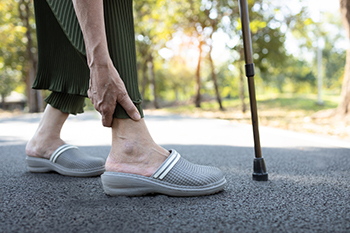
Senior citizens can sometimes be more likely to develop afflictions of the foot than younger individuals. Therefore, it is especially important that seniors take extra special care to maintain the health of their feet. One of the ways in which this can be done is by trimming the nails correctly. Trimming the nails may be difficult for seniors because the nails can be difficult to reach. Some seniors, particularly those who are living with arthritis, may also struggle with being able to have a firm grip on the nail cutter. It is important to remember that one should not cut the nail too short, as this can lead to the development of an ingrown toenail. Additionally, the nail should be cut straight to prevent an ingrown toenail. If you are a senior, it is a good idea to make an appointment with a podiatrist today for more information.
Proper foot care is something many older adults forget to consider. If you have any concerns about your feet and ankles, contact Scott Matthews, DPM, MD from Salem Foot Care . Our doctor can provide the care you need to keep you pain-free and on your feet.
The Elderly and Their Feet
As we age we start to notice many changes in our body, but the elder population may not notice them right away. Medical conditions may prevent the elderly to take notice of their foot health right away. Poor vision is a lead contributor to not taking action for the elderly.
Common Conditions
- Neuropathy – can reduce feeling in the feet and can hide many life-threatening medical conditions.
- Reduced flexibility – prevents the ability of proper toenail trimming, and foot cleaning. If left untreated, it may lead to further medical issues.
- Foot sores – amongst the older population can be serious before they are discovered. Some of the problematic conditions they may face are:
- Gouging toenails affecting nearby toe
- Shoes that don’t fit properly
- Pressure sores
- Loss of circulation in legs & feet
- Edema & swelling of feet and ankles
Susceptible Infections
Diabetes and poor circulation can cause general loss of sensitivity over the years, turning a simple cut into a serious issue.
If you have any questions please feel free to contact our office located in Wikesboro, NC . We offer the newest diagnostic and treatment technologies for all your foot and ankle needs.
Active Children May Be Prone to Getting Sever’s Disease

Sever’s disease is a condition that affects children and young teenagers who participate in running and jumping activities. A noticeable symptom is heel pain, and this can occur when the muscles and tendons grow at different rates. Many parents may become aware of this foot condition when they notice their child is limping and complaining of heel pain. Relief is often sought at this time, despite the fact that children may outgrow this condition as the aging process occurs. Mild comfort may be found when the feet are rested as often as possible, in addition to wearing cushioned pads at the heel of the shoes. It is beneficial to temporarily stop the activity that caused this ailment, and replace it by performing specific stretches. An effective stretch is done by standing on a step, and lowering the heels one at a time until a gentle pull is felt. Sever’s disease can cause your child to have heel pain, and it is strongly urged that you consult a podiatrist who can help you and your child manage this condition.
Sever's disease often occurs in children and teens. If your child is experiencing foot or ankle pain, see Scott Matthews, DPM, MD from Salem Foot Care . Our doctor can treat your child’s foot and ankle needs.
Sever’s Disease
Sever’s disease is also known as calcaneal apophysitis, which is a medical condition that causes heel pain I none or both feet. The disease is known to affect children between the ages of 8 and 14.
Sever’s disease occurs when part of the child’s heel known as the growth plate (calcaneal epiphysis) is attached to the Achilles tendon. This area can suffer injury when the muscles and tendons of the growing foot do not keep pace with bone growth. Therefore, the constant pain which one experiences at the back of the heel will make the child unable to put any weight on the heel. The child is then forced to walk on their toes.
Symptoms
Acute pain – Pain associated with Sever’s disease is usually felt in the heel when the child engages in physical activity such as walking, jumping and or running.
Highly active – Children who are very active are among the most susceptible in experiencing Sever’s disease, because of the stress and tension placed on their feet.
If you have any questions, please feel free to contact our office located in Wikesboro, NC . We offer the newest diagnostic and treatment technologies for all your foot and ankle injuries.
How Can Diabetic Patients Check the Soles of Their Feet?

Diabetes is a serious condition and can lead to complications regarding the feet if not under the care of a podiatrist. Elevated blood sugar levels may lead to the inability to feel existing cuts on the feet. These can easily develop into foot ulcers and may be controlled by implementing healthy lifestyle habits. Drinking plenty of water daily, reducing sugar intake, and practicing a gentle exercise regime are a few ways that can guide the diabetic person to possibly feeling better. It is necessary to pay close attention to the feet, and the soles can be inspected daily by using a mirror. This is an effective method for noticing any cuts, bruises, or scrapes that have developed, and they may be easier to see than to feel. Good foot hygiene consists of trimming the toenails weekly, which is often performed by a podiatrist. Diabetic patients may notice the skin on their feet is excessively dry and cracked, which may indicate additional foot problems. If you have diabetes, it is strongly advised that you are under the care of a podiatrist who can treat this ailment, and help you manage it.
Diabetic foot care is important in preventing foot ailments such as ulcers. If you are suffering from diabetes or have any other concerns about your feet, contact Scott Matthews, DPM, MD from Salem Foot Care . Our doctor can provide the care you need to keep you pain-free and on your feet.
Diabetic Foot Care
Diabetes affects millions of people every year. The condition can damage blood vessels in many parts of the body, especially the feet. Because of this, taking care of your feet is essential if you have diabetes, and having a podiatrist help monitor your foot health is highly recommended.
The Importance of Caring for Your Feet
- Routinely inspect your feet for bruises or sores.
- Wear socks that fit your feet comfortably.
- Wear comfortable shoes that provide adequate support.
Patients with diabetes should have their doctor monitor their blood levels, as blood sugar levels play such a huge role in diabetic care. Monitoring these levels on a regular basis is highly advised.
It is always best to inform your healthcare professional of any concerns you may have regarding your feet, especially for diabetic patients. Early treatment and routine foot examinations are keys to maintaining proper health, especially because severe complications can arise if proper treatment is not applied.
If you have any questions please feel free to contact our office located in Wikesboro, NC . We offer the newest diagnostic and treatment technologies for all your foot and ankle needs.
Diabetic Foot Care
Diabetes can cause two problems that can potentially affect the feet: Diabetic neuropathy and Peripheral Vascular Disease. Diabetic neuropathy occurs when nerves in your legs and feet become damaged, which prevents you from feeling heat, cold, or pain. The problem with diabetic neuropathy is that a cut or sore on the foot may go unnoticed and the cut may eventually become infected. This condition is also a main cause of foot ulcers. Additionally, Peripheral vascular disease also affects blood flow in the body. Poor blood flow will cause sores and cuts to take longer to heal. Infections that don’t heal do to poor blood flow can potentially cause ulcers or gangrene.
There are certain foot problems that are more commonly found in people with diabetes such as Athlete’s foot, calluses, corns, blisters, bunions, foot ulcers, ingrown toenails, and plantar warts. These conditions can lead to infection and serious complications such as amputation. Fortunately, proper foot care can help prevent these foot problems before they progress into more serious complications.
Each day you should wash your feet in warm water with a mild soap. When you finish washing your feet, dry them carefully especially between your toes. You should also perform daily foot inspections to ensure you don’t have any redness, blisters, or calluses. Furthermore, if you are diabetic, you should always wear closed-toed shoes or slippers to protect your feet. Practicing these tips will help ensure that your feet are kept healthy and away from infection.
If you have diabetes, contact your podiatrist if you have any of the following symptoms on your feet: changes in skin color, corns or calluses, open sores that are slow to heal, unusual and persistent odor, or changes in skin temperature. Your podiatrist will do a thorough examination of your feet to help treat these problematic conditions.
Children’s Foot Fractures

A children’s foot fracture is a broken bone in a child’s foot. If your child complains of pain in their foot, there is swelling, they seem to have trouble moving their foot or walking, their foot is bruised or appears misshapen, they may have broken their foot. A podiatrist will examine the foot, checking for decreased movement, skin breaks, and lack of feeling. An X-ray, MRI, or CT scan may be done to check for broken bones or other injuries. If it is found that the child does have a foot fracture, treatments include casting or splinting the broken foot to prevent movement and help the foot to heal, providing necessary medication to prevent infection, and possibly performing surgery. A child with a potential or known foot fracture should rest the foot and avoid activities that cause pain, elevate the foot, and ice it to prevent swelling. If you suspect your child has a fractured foot, see a podiatrist as soon as possible for treatment and to prevent complications.
A broken foot requires immediate medical attention and treatment. If you need your feet checked, contact Scott Matthews, DPM, MD from Salem Foot Care . Our doctor can provide the care you need to keep you pain-free and on your feet.
Broken Foot Causes, Symptoms, and Treatment
A broken foot is caused by one of the bones in the foot typically breaking when bended, crushed, or stretched beyond its natural capabilities. Usually the location of the fracture indicates how the break occurred, whether it was through an object, fall, or any other type of injury.
Common Symptoms of Broken Feet:
- Bruising
- Pain
- Redness
- Swelling
- Blue in color
- Numbness
- Cold
- Misshapen
- Cuts
- Deformities
Those that suspect they have a broken foot shoot seek urgent medical attention where a medical professional could diagnose the severity.
Treatment for broken bones varies depending on the cause, severity and location. Some will require the use of splints, casts or crutches while others could even involve surgery to repair the broken bones. Personal care includes the use of ice and keeping the foot stabilized and elevated.
If you have any questions please feel free to contact our office located in Wikesboro, NC . We offer the newest diagnostic and treatment technologies for all your foot and ankle needs.



